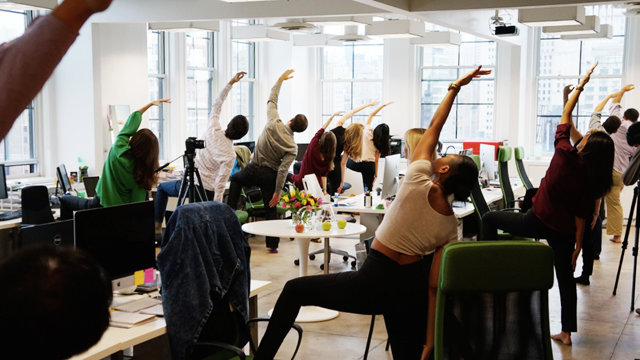There’s no question that to survive in today’s 24-7 work world, many of us have had to make a lot of adjustments and sacrifices. Yet for all of our adaptability, there is one thing that people have stayed resolutely against: “No one wants to be in gym shorts in front of their boss,” says Jennifer Kluczkowski.
This presented a big problem to Kluczkowski and her business partner Chiyoko Osborne, old friends who six months ago decided to create Yoga Means Business, a company that brings yoga to the workplace. A Jivamukti-trained instructor who travels annually to India to deepen her practice, Kluczkowski knew that few places needed soothing yoga and meditation more than stressed-out, frenetic office environments; but when she and Osborne would hold hour-long sessions that required everyone to come to the conference room in their workout gear and get onto a mat, turnout was generally low. “Since the benefits of yoga are so well known, we wanted to understand why the rest of the group wasn’t joining,” says Kluczkowski. “We created an informal focus group of friends and learned that asking people to put on Spandex, in front of coworkers, and then wobble awkwardly for an hour was just too much.”

So they changed the entire approach and overhauled Yoga Means Business. First change: the hour-long session was shortened and branded the YMB 30-Minute Method. Second change: No more yoga outfits. Or mats. Participants sit in their office chairs in their suits, ties, and other business attire. “People are busy. It’s asking too much of them to leave the office in the middle of the workday; even changing clothes twice takes too much time,” says Osborne, the marketing brains of the company. “That drove home our business model of sending yoga teachers into companies and using whatever office space they have available. We have yet to find an office we cannot hold a class in.”
While the women had to completely revolutionize their thinking, they still have a very traditional belief in yoga’s power. “Although we’re providing a new method, we stay deeply rooted in the teachings,” says Kluczkowski. “In each session, our clients learn pranayama (breath control to steady the mind), asana (physical postures to increase flexibility and reduce tension/tightness), and dharana (a form of meditation to cultivate single-pointed focus).”
The ability to effectively adapt is not surprising, considering it was the original impetus behind the business. Osborne and Kluczkowski had been friends for nearly a decade and both had successful, separate careers in marketing (Osborne) and advertising (Kluczkowski). But they shared an interest in yoga and in working together. Instead of buying a studio, they got creative. “A path to start a business together finally emerged where we could combine my marketing and branding background with Jen’s yoga expertise,” says Osborne, who previously worked building brands for Calvin Klein, Alexander Wang, Johnson & Johnson, and Pepsi. “In short, our magic formula: She’s the yoga, I’m the business.”
Both, however, are the investors, as the company was funded by what Osborne describes as “our personal savings accounts and unprecedented levels of optimism.” And while that optimism, coupled with an aggressive networking push, has led to clients including Facebook, L’Oreal, and Gilt Groupe, they are nowhere near the end of their shared vision. Says Osborne: “We dream big over here. Our goal is to create one of the largest yoga schools without actually owning a brick-and-mortar location.”
From: Fast Company

